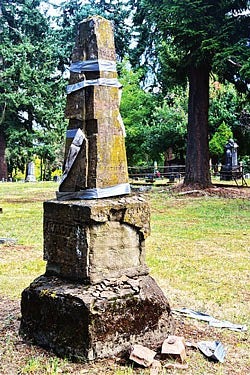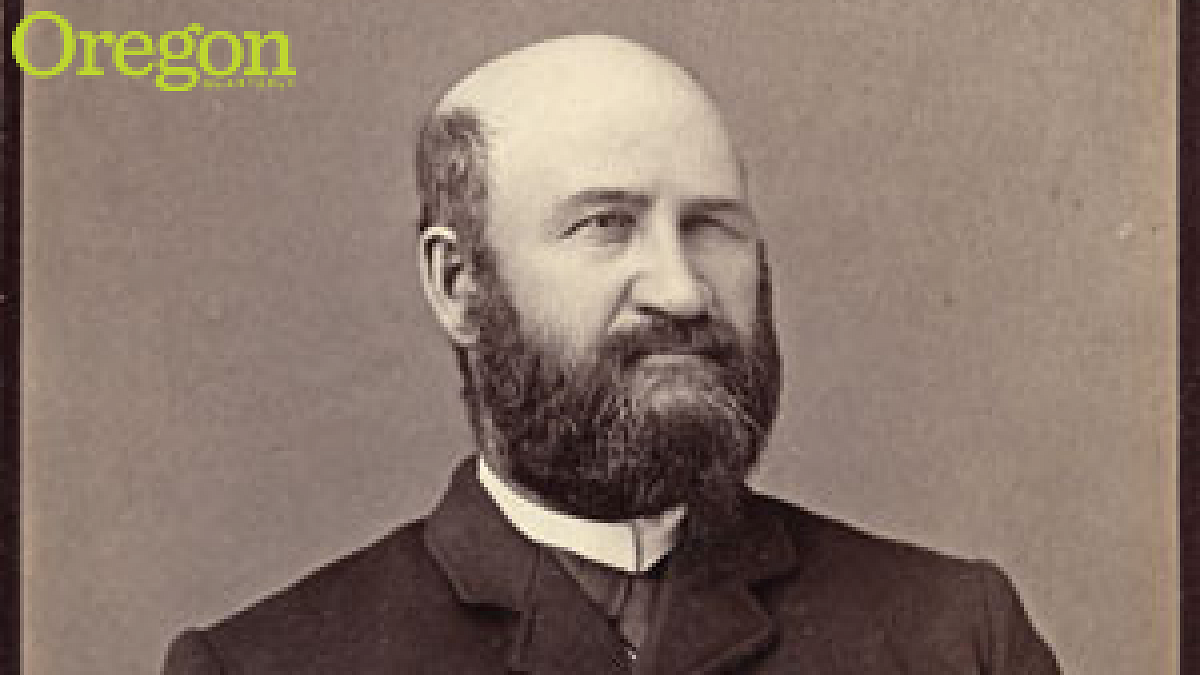When Judge Joshua Jones Walton Jr. was buried on December 23, 1909, the entire rolling stock of the Eugene street railway line was needed to convey the crowd of mourners following his coffin to the cemetery. Deemed by the Daily Guard as “one of the largest funerals ever held in Eugene,” Walton’s service included a number of leading locals including University president Prince Lucien Campbell as pallbearer. A pioneer, a lawyer, and a UO founding father, Walton lived for seventy-one years, fifty-one of which he spent in Eugene earning a reputation as one of the state’s most highly respected citizens. Now, more than a century after his death, the monument standing sentinel over the graves of the judge and his family crumbles into ruins, held up by nothing more than duct tape and the good intentions of a few community members.
The word territory still tailed Oregon’s name and Eugene wasn’t yet a city when the Waltons arrived out West. The eldest of eight children, Walton was born in Rushville, Indiana, to Joshua Jones Walton Sr. and Ann Shockley (whose first cousin, the family claims, was the soon-to-be famous Confederate general Robert E. Lee). Walton was just eleven when his family left all they knew to travel 2,200 miles on the first gold-dusted surge of western migration. The family’s pioneer past would be fundamental to their legacy; one of the few engravings still visible on the Walton obelisk reads “crossed the plains with ox team 1849.”

Their hardscrabble journey into the unknown included giving birth along the trail (Walton’s sister Amanda was born in Humboldt County, California, at the end of the family’s westward trek) and surviving the opening blows of the Rogue River Wars. Driven north by the carnage, the family settled in Eugene in 1858, where Walton began reading law and joined the city’s bar association. In the decades to come, he moved between positions of power, serving as a deputy district attorney, U.S. land commissioner, and state legislator. He also became a judge, a position that made his name well known throughout Lane County. When Route 126 opened up the county’s western edge, the then-new town of Walton took its name from the notable local.
Walton’s best move, however, came later when he claimed the University of Oregon for Eugene. He was instrumental in convincing the Oregon legislature to choose not Salem, not Portland, but the lesser-known, lesser-populated Eugene for the location of the state’s flagship university. He smoothed flared tempers as the community strained to raise the school’s seed money ($50,000, equal to about $900,000 today). When even that large sum wasn’t enough, the judge, cemetery lore holds, left his chambers to go door-to-door seeking donations. He took anything, from chickens to bushels of wheat, that could be bartered for the funds needed to complete the UO’s first building. With Walton’s support, the city rallied and Deady Hall got its roof.
For thirty more years, Walton continued to watch over the school as a member of the Board of Regents. He also saw two of his own children attend the UO. Daughter Ada began classes the first day the school opened, eventually earning her degree in 1885. Walton’s youngest child, Pauline, graduated in 1906 and spent twenty-five years working with the University library. She was the only one of her father’s children to see his service to the UO formally recognized in 1957 when his name was chosen for the school’s new residence hall. In the ensuing five decades, more than 30,000 new Ducks have called the Walton Complex home.
The family’s own residence also has its part in Eugene history. Driving along Franklin Boulevard, generations of people have passed by what was, first, the Walton homestead, then, for decades, Moreno’s Mexican Restaurant, and most recently, Bates Steak House and Saloon. When Walton owned the land, orchards covered it and a water tower rose roughly where the U.S. District Courthouse stands today. The Waltons called 433 East Broadway home for almost a hundred years until daughter Pauline sold the house shortly before her death in 1966.
Pauline was the last Walton to join the family plot in the Eugene Pioneer Cemetery, where the judge had been laid to rest fifty-seven years earlier. Bordered on three sides by the UO campus, the cemetery’s sixteen acres are maintained by the Eugene Pioneer Cemetery Association (EPCA) with the Walton memorial standing just off its center square. To keep stone pieces from falling on to passersby, the EPCA elected to mummify the memorial in duct tape. The unsightly result raised much concern in citizens who contacted the EPCA fearing the historic site had been vandalized. By the end of 2012, the association plans to do away with the tape and replace the obelisk.
“The original monument was made of sandstone from the old Eugene quarry,” says EPCA member Dorothy Brandner. “That type of stone erodes very quickly so it makes more sense to simply build a new monument using granite.”
This heartier material, EPCA members hope, will keep the memorial as much a part of Oregon history as is the family it honors.
—By Elisabeth Kramer '12


